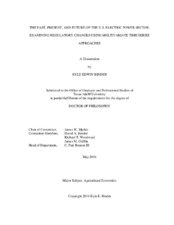| dc.description.abstract | The U.S. energy sector has undergone continuous change in the regulatory, technological, and market environments. These developments show no signs of slowing. Accordingly, it is imperative that energy market regulators and participants develop a strong comprehension of market dynamics and the potential implications of their actions. This dissertation contributes to a better understanding of the past, present, and future of U.S. energy market dynamics and interactions with policy. Advancements in multivariate time series analysis are employed in three related studies of the electric power sector. Overall, results suggest that regulatory changes have had and will continue to have important implications for the electric power sector. The sector, however, has exhibited adaptability to past regulatory changes and is projected to remain resilient in the future.
Tests for constancy of the long run parameters in a vector error correction model are applied to determine whether relationships among coal inventories in the electric power sector, input prices, output prices, and opportunity costs have remained constant over the past 38 years. Two periods of instability are found, the first following railroad deregulation in the U.S. and the second corresponding to a number of major regulatory changes in the electric power and natural gas sectors.
Relationships among Renewable Energy Credit prices, electricity prices, and natural gas prices are estimated using a vector error correction model. Results suggest that Renewable Energy Credit prices do not completely behave as previously theorized in the literature. Potential reasons for the divergence between theory and empirical evidence are the relative immaturity of current markets and continuous institutional intervention.
Potential impacts of future CO2 emissions reductions under the Clean Power Plan on economic and energy sector activity are estimated. Conditional forecasts based on an outlined path for CO2 emissions are developed from a factor-augmented vector autoregressive model for a large dataset. Unconditional and conditional forecasts are compared for U.S. industrial production, real personal income, and estimated factors. Results suggest that economic growth will be slower under the Clean Power Plan than it would otherwise; however, CO2 emissions reductions and economic growth can be achieved simultaneously. | en |


